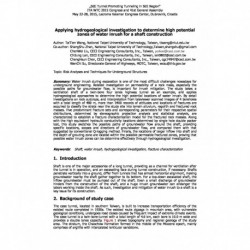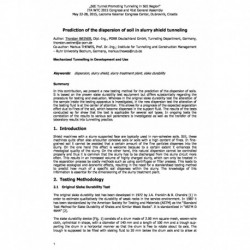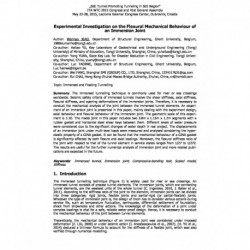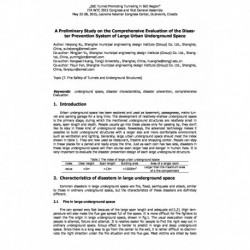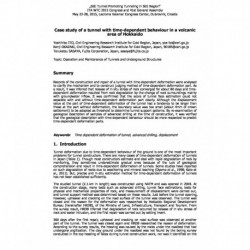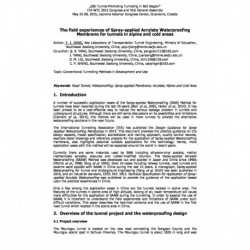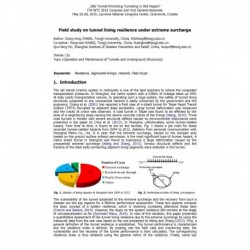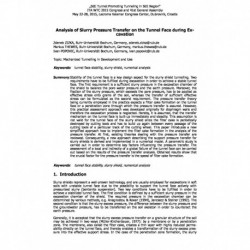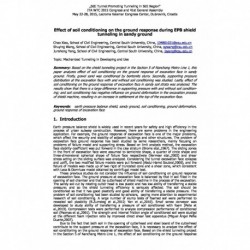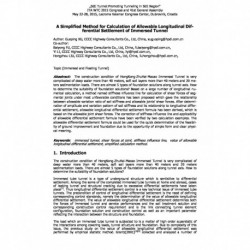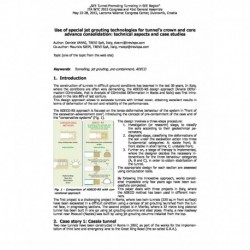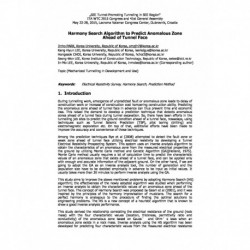No document
Search & filter
Search for a publication
Search & filter
World Tunnelling Congress
WTCThere are 1984 documents.
-
Applying hydrogeological investigation to determine high potential zones of water inrush for a shaft construction
Abstract: Shaft is one of the major accessories of a long tunnel, providing as a channel for ventilation after the tunnel is in operation, and an excavating face during tunnel construction, if necessary. Shafts penetrate vertically into a ground, differ from tunnels that has almost horizontal alignment, making groundwater nearby the shaft gather together to its bottom. For a top-down excavated shaft, the...
0,00 € -
Prediction of the dispersion of soil in slurry shield tunneling
Abstract: Shield machines with a slurry supported face are typically used in non-cohesive soils. Still, these machines quite often also encounter cohesive soils or soils with a high content of fines. In fine-grained soil it cannot be avoided that a certain amount of the fine particles disperses into the slurry. On the one hand this effect is welcome because to a certain extent it enhances the rheological...
0,00 € -
Experimental Investigation on the Flexural Mechanical Behaviour of an Immersion Joint
Abstract: The immersed tunnelling technique (Figure 1) is widely used for river or sea crossings. An immersed tunnel consists of precast tunnel elements. The immersion joints, which are connecting tunnel elements, are the weakest units of the whole tunnel (C. Ingerslev, 2010, J. Baber et al., 2011). According to the stiffness ratio of the joint to the element, immersion joints can be divided into three...
0,00 € -
A Preliminary Study on the Comprehensive Evaluation of the Disaster Prevention System of Large Urban Underground Space
Abstract: Urban underground space has been explored and used as basement, passageway, metro tun-nel and parking garage for a long time. The development of relatively shallow underground space is the primary stage, during which the mentioned underground structures are relatively small in scale, span length and depth. People usually go into these places only for passing by, they don’t like to stay in these...
0,00 € -
Case study of a tunnel with time-dependent behaviour in a volcanic area of Hokkaido
Abstract: Records of the construction and repair of a tunnel with time-dependent deformation were analysed to clarify the mechanism and to construct judging method of time-dependent deformation part. As a result, it was inferred that release of in situ stress of rock converged for about 80 days and time-dependent deformation resulted from rock degradation by the change of rock surroundings mainly with...
0,00 € -
The field experiences of Spray-applied Acrylate Waterproofing Membrane for tunnels in alpine and cold areas
Abstract: A number of successful application cases of the Spray-applied Waterproofing (SAW) Method for tunnels have been reported during the last 20 years (Blair et al., 2005; Holter et al., 2014). It has been proved to be a cost-effective way to reduce the serious leakage problem in tunnels and underground structures. Although there are still some discussions on its possibilities and limitations...
0,00 € -
Initial proposal and discussion on performance based waterproofing design for mountain tunnels
Abstract: There is a saying: nine in ten tunnels seepage in tunnel and underground engineering in China. It’s not much exaggerated as severe leakage and repeat maintenance. For a long time, we put the problem mainly due to the traditional waterproofing sheets. As to the mountain tunnels of composite tunnel lining the waterproofing sheet membrane is sandwiched between temporary sprayed concrete lining and...
0,00 € -
Stress analysis of cylindrical tunnel with void behind the lining
Abstract: Tunnels in Japan, many of which are constructed by conventional tunnelling methods, often have voids behind the lining, i.e., which often have partial discontinuities between the lining and ground. There are two main reasons why tunnels constructed by the method have voids. One is the supporting member. Not the sprayed concrete but the sheet pile is used as the primary support. Therefore,...
0,00 € -
Numerical modeling of the seepage erosion process around tunnels using DEM
Abstract: For a shield driven tunnel with segmental lining built in saturated soils, the tunnel convergence and differential longitudinal settlement may induce the opening and stagger of segmental joints and generate segmental cracks. Therefore, the leakage frequently happens at the locations such as the circumferential and longitudinal segmental joints, cracks and grouting holes. In the low permeability...
0,00 € -
Field study on tunnel lining resilience under extreme surcharge
Abstract: The rail transit (metro) system in metropolis is one of the best solutions to relieve the congested transportation pressures. In Shanghai, the metro system with a 538km of mileage takes up 43% of daily public transportation volume. In operating such a huge system, the safety of tunnel lining structures subjected to any unexpected hazards is badly concerned by the government and the engineers....
0,00 € -
Analysis of Slurry Pressure Transfer on the Tunnel Face during Excavation
Abstract: Slurry shields represent a well-proven technology, and are usually employed for excavations in soft soils with unstable tunnel face due to the possibility to support the tunnel face actively with pressurized slurry (bentonite suspension). Two key conditions have to be fulfilled in order to achieve a stabilized tunnel face. The first condition is defined by a sufficient slurry pressure in the...
0,00 € -
Effect of soil conditioning on the ground response during EPB shield tunneling in sandy ground
Abstract: Earth pressure balance shield is widely used in recent years for safety and high efficiency in the process of urban subway construction. However, there are some problems in the engineering application. For example, the ground response of excavation face is one of the major problems, which affect the security and stability of adjacent buildings and other structures. The problem of excavation...
0,00 € -
Study on Effect of Excavation of Pit on Its Underlying Metro Tunnel
Abstract: With rapid development of underground rail transport in China, effect of foundation pit excavation on underlaid metro tunnel has been increasingly concerned since the 21st century. The excavation inevitably leads to the upheaval of the tunnel. If the deformation values of tunnel exceed their allowable values, the safe performance of tunnel will be affected. Many scholars carried out some...
0,00 € -
A Simplified Method for Calculation of Allowable Longitudinal Dif ferential Settlement of Immersed Tunnel
Abstract: The construction condition of HongKong-ZhuHai-Macao Immersed Tunnel is very complicated of deep water more than 40 meters, soft soil layers more than 40 meters and 20 meters sedimentation loads. There are almost 5 types of foundation solutions along tunnel axis. How to determine the suitability of foundation solutions? Immersed tube tunnel is a type of underground structure which is sentisitive...
0,00 € -
Use of special jet grouting technologies for tunnel’s crown and core advance consolidation: technical aspects and...
Abstract: The construction of tunnels in difficult ground conditions has boomed in the last 30 years. In Italy, where the conditions are often very demanding, the ADECO-RS design approach (Analisi DEfor-mazioni COntrollate, that is Analysis of COntrolled DEformation in Rocks and Soils) was first intro-duced in the late 80’s of last century. The ADECO-RS approach is focused on the tenso-deformative...
0,00 € -
Harmony Search Algorithm to Predict Anomalous Zone Ahead of Tunnel Face
Abstract: During tunnelling work, emergence of unpredicted fault or anomalous zone leads to delay of construction work or increase of construction cost hampering construction ability. Predicting the anomalous zone ahead of tunnel face in advance can thus prevent time and economic loss. This raised the demand to develop a prediction technique that detects anomalous zones ahead of a tunnel face during...
0,00 €

